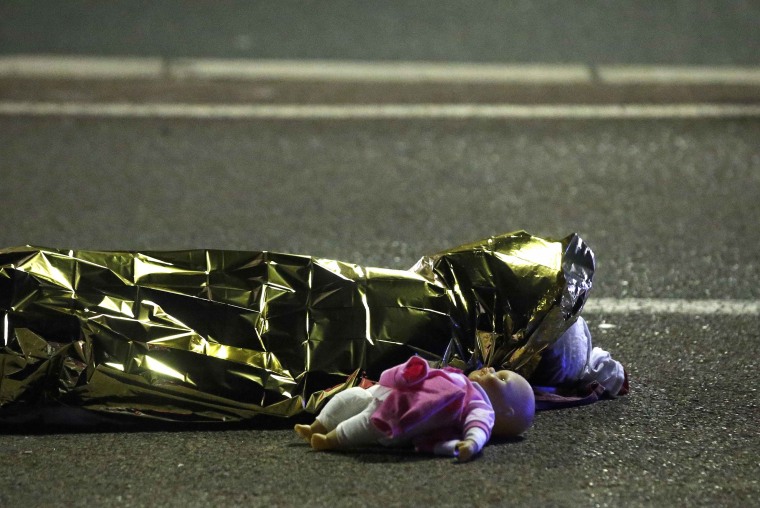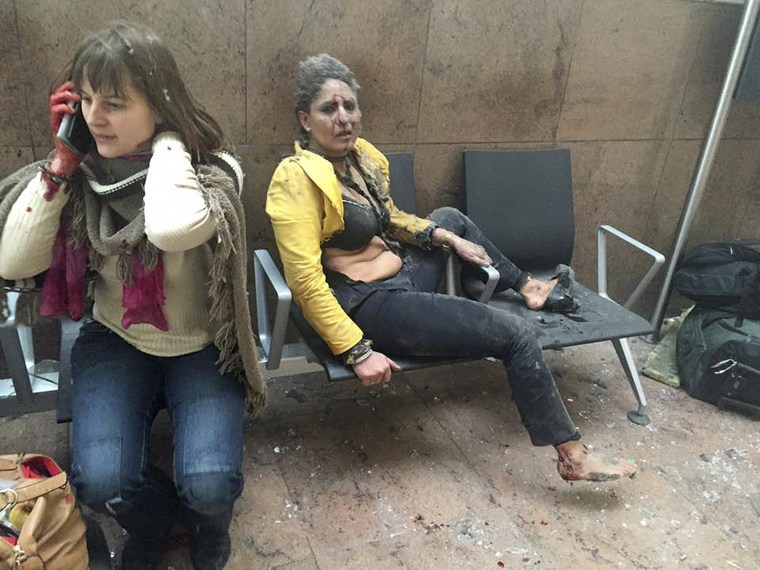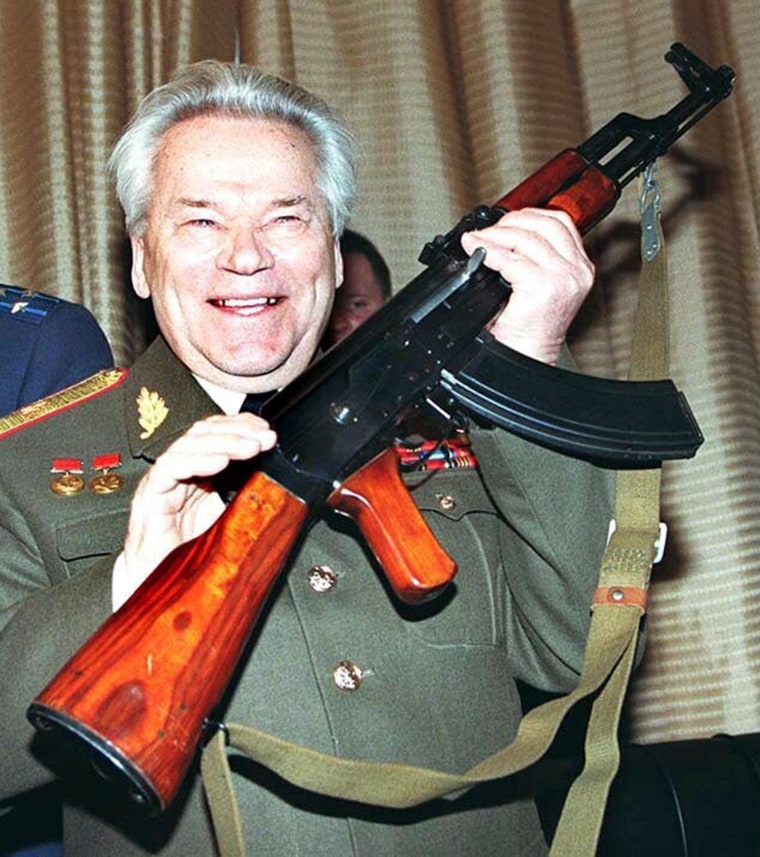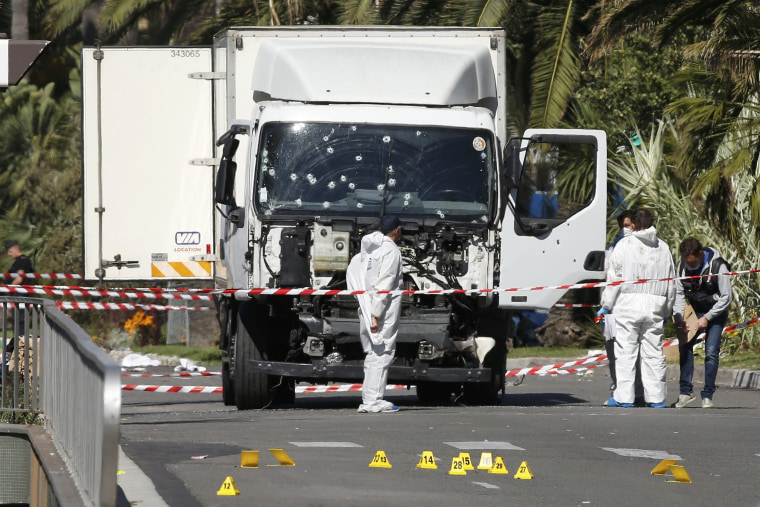Part Five in a Series
NICE, France — Kinetic energy is calculated as an expression of mass and velocity.
According to statements by French prosecutors, the vehicle that drove for more than a mile along a thoroughfare crowded with pedestrians celebrating Bastille Day in Nice on July 14 was an 18-ton truck, driven at speeds of up to 70 miles per hour.

From these sparse facts, rough mathematical calculations are simple. At its fastest, the truck was delivering kinetic energy of up to 12.6 megajoules — equivalent to 14 sticks of military-grade dynamite — to anyone in its path.
Eighty-six people killed. Two hundred injured. Ten children dead; thirty-four in intensive care.
One madman.
Horrors like the attack in Nice have become commonplace enough that we can make spreadsheets of shattered lives.
But is there anything we can actually do in the wake of such attacks, except tally up the dead?
The Shape of Modern Terror
In terms of the frequency of attacks in the West, terrorism is not at its peak.
That occurred in 1979 — with another spike occurring in the early 1990s. This was largely due to a proliferation of state-sponsored terrorist organizations during the Cold War, which served the goals of numerous state actors.
Since that time, there has been a sharp decline in the number of attacks, including those against the U.S. and its citizens.
“Annually, about 35 percent to 40 percent of transnational terrorist incidents are against U.S. interests even though relatively few such incidents occurred on U.S. soil during the past two decades,” Todd Sandler, a researcher at the University of Texas at Dallas, noted in a recent study. “This is a clear indication of the transference of attacks from secure U.S. borders to foreign venues.”
However, what worries most researchers is that although the number of attacks is declining, their lethality is increasing.
“Perhaps the most striking development is that terrorism has become bloodier, in terms of what acts are committed and how many victims are involved,” wrote Brian Michael Jenkins, a terrorism expert at the RAND Corporation.
Data compiled by Penn State University researcher James Piazza supports this claim.
Until 1979, transnational terror attacks averaged about two victims — killed or injured — per attack. In the 1980s, this increased to nearly four victims per attack, and in the 1990s it went up to 10 people. By 2005, the last year for which Piazza’s report compiled data, that number had increased to 11.
During this same period, the total volume of attacks declined. So despite fewer attacks, more people were being killed or injured in each incident.
It is also true that most of the world’s terror attacks do not occur in the wealthy nations of the West, but in countries with active conflicts or low-intensity insurgencies.
“Terrorism remains highly concentrated with most of the activity occurring in just five countries — Iraq, Nigeria, Afghanistan, Pakistan and Syria,” according to the 2015 Global Terror Index from the non-profit Institute for Economics and Peace. “These countries accounted for 78 percent of the lives lost in 2014.”
This report also suggested that, contrary to most of the public discourse surrounding terrorism, religious extremists were not the primary cause of attacks in the West.
“Islamic fundamentalism was not the primary driver of lone-wolf attacks, with 80 percent of deaths in the West from lone-wolf attacks being attributed to a mixture of right-wing extremists, nationalists, anti-government elements, other types of political extremism and supremacism.”
Further data compiled by the University of Maryland’s National Consortium for the Study of Terrorism and Responses to Terrorism, better known as START, shows that over the 44-year period from 1970-2014 in the United States, about 61 percent of all participants in terror attacks “were most commonly groups or organizations based in the United States.”
It is worth noting that since those reports were issued, the bulk of major terror attacks in North America and Europe in 2015 and 2016 — Paris, Brussels, Orlando, Nice — were carried out by ISIS-linked or inspired radicals.
As ISIS is defeated on the battlefield in Iraq and Syria, it is becoming more dangerous abroad.
Active Proliferation
The shockwave of the blast traveled at 17,500 feet per second.
It extended in an expanding radius from the bomb, which had been constructed inside a cheap rolling suitcase.
We’ve been trained by movies to think that people can react when a bomb goes off; that there is something you can do: leap heroically behind a barrier, or dive to the ground. But 17,500 feet per second is fast. It is faster than human reaction. Neural impulses travel through nerve fibers at about 350 feet per second, while motor function commands travel at a leisurely 100 feet per second. An explosion is the literal definition of an event you don’t realize has happened until it’s too late.
The explosion knocked people over as if they were cardboard cutouts.
Within the immediate vicinity of an explosive device, there are no lucky people. There are only varying degrees of unluckiness. Those with no luck at all die. Some of the more fortunate will only have their eardrums shattered, or suffer traumatic brain injury from the concussive effect of a wall of air and dust, moving at more than 15 times the speed of sound.
Pain travels even more slowly, at perhaps two feet per second.
That explosive blast on March 22 created a storm of over-pressurized air, fragments, heat and fire. In front of this, among the 38 killed and dozens wounded at Brussels Zaventem Airport that day, was a mother and her toddler.
Video captured by a taxi driver of the scene’s aftermath shows the little girl, caked in soot, char and debris, sobbing over the prone form of her mother. Although they were seriously wounded, somehow both survived.
The bomb that injured them was constructed using an explosive called triacetone triperoxide, or TATP.
Despite its recent emergence as a tool of terror in European cities, TATP is not a new threat, nor is it particularly effective as far as explosive agents are concerned. It was frequently a regular component in suicide devices in the 1980s used in the Israeli-Palestinian conflict.
The bulk of terror attacks — indeed, of mass killings of any kind — are carried out with explosives or with small arms designed for the battlefield. In this context, one of the most worrying trends is the sharp increase in global small arms trade and availability of explosives or their precursor components and the information to use them.
Many reports in the immediate aftermath of the Brussels bombing focused on ISIS’ “new” weapon created by “experienced” bombmakers, but the truth is that making TATP is not difficult.
Even relatively ineffective homemade explosives like TATP can be deadly in sufficient quantities, or if the device is constructed to maximize its potential.

What makes it especially attractive to would-be terrorists is that it can be made from easily attainable components.
Many of these items can be found in beauty shops and pharmacies. Although there are controls in place designed to prevent people from acquiring large amounts of the precursor elements, they are common elements widely available in numerous household products.
“The precursors [for TATP] are widely available and cannot be removed from commerce,” wrote the authors of a paper prepared for the Department of Homeland Security in 2008. Therefore, “we have identified ways to denature these precursors to prevent illicit use without adverse effect on their legitimate use.”
The European Union’s updated its laws governing the regulation of precursor chemicals for explosives in January 2015, based upon a proposal initially put forth in 2008. After the November attacks in Paris, it tabled another set of proposals:
“We also bring to the table an EU Action Plan on firearms and explosives in order to cut the access of terrorists to the traffickers within the EU and on our periphery,” said European Commissioner for Migration, Home Affairs and Citizenship Dimitris Avramopoulos. “Europe needs to act together, decisively and swiftly, to crack down on terrorism and improve our security.”
Related: Take a Rare Look Inside an Elite Anti-ISIS Unit
However, the plan highlighted the essential difficulty in controlling explosive precursors: it requires intense cooperation between national authorities. Other than recommendations for increased cooperation at the national level, it offered little of substance, such as regulations intended to encourage manufacturers to denature — or render ineffective — precursors of TATP and other explosives, or mandating blast-mitigation design for large buildings and public spaces.
The focus on TATP in the wake of the Brussels airport bombing echoed similar hype surrounding the Paris attacks on Nov. 13, in which the attackers were described as using commando-like tactics to carry out France’s worst mass-killing in decades.

The eagerness to ascribe advanced lethal training and tactics to the attackers in Paris and Brussels obscured the reality.
With few exits and a densely crowded open room, the Bataclan theater is what military professionals call a “kill box.”
"The attackers had automatic weapons and were killing unarmed densely packed civilians. Cold blood was required, not military skills,” Jenkins said.
Assault rifles are now easy to obtain almost anywhere in the world. Most of these are based on two Cold War-era designs, the Kalashnikov-variant and adaptations of the AR-15.
“Today the Kalashnikov and AR-15 variants remain the most commonly seen weapons on modern battlefields; their use is central to almost every war,” wrote C.J. Chivers, a journalist at The New York Times specializing in modern weaponry and conflict. “They are a staple of insurgency and terrorism and all but fundamental to the grim routine of mass shootings.”
Related: Paris Attacks Inspire Huge Influx of Police Recruits
Efforts undertaken by the EU to control the inflow of illegal firearms to its member states in the wake of the November attacks have repeatedly stalled in committee, over objections from various gun lobbies, including hunters and militia members.
“Governments have done little to stop the spread of this class of weapons," Chivers wrote. "Often, as in the case of the United States, they have contributed to it. There is no end in sight.”
A New Mindset
“I will once again put our military into its highest condition of security, which will allow the mobilization of 10,000 military personnel across the country,” President Francois Hollande told his countrymen on July 15, the morning after the Bastille Day attack in Nice.
Thus began the now-familiar routine of speeches and special initiatives in the wake of a major terror attack.
It isn’t clear how the additional soldiers could have prevented the attack in Nice. France was already in a state of emergency. Law enforcement and military personnel were already working extra hours, patrolling France’s major cities.
Calling up additional troops is a measurable act. It gave France’s government a concrete answer to the question: “What are you doing to stop this from happening again?”
This is the central problem at the heart of counterterrorism. There is never enough you can do: despite altered and new laws after Nov. 13; despite a national state of emergency, heightened security practices and increased intelligence gathering; despite more than 3,500 raids of suspected Islamist radicals across France; a radicalized, violent and unbalanced individual was able to kill dozens of innocents in full view of the authorities.
“Unfortunately, governments have communicated to their citizens that they can — or their critics say, should — provide protection,” said Jenkins, the counterterrorism expert at RAND. “Yes, providing for ‘the common defense’ is a basic function of government, but defense of the nation is not the same as guaranteeing every citizen’s safety.”
“Protection alone is always going to be imperfect, because terrorists act in a rational manner,” said Francois Heisbourg, special adviser to the Foundation for Strategic Research, a French think-tank specializing in security. “They may be ideologically unbalanced, but they are not tactically irrational. They will always go after targets that are insufficiently protected.”
"We may have to live with terrorism, but we do not have to live in terror"
One of the successes in the post-9/11 world of counterterrorism is the degree to which authorities have become successful at disrupting organized cross-border terror attacks. Jenkins estimates U.S. authorities are “batting .900,” meaning they have thwarted about 90 percent of all organized terror plots since Sept. 11, 2001.
Unfortunately, as is the case with any kind of criminality, this has created a displacement effect: would-be terrorists now plan and execute attacks without coordination from overseas.
They act alone, as appears to have been the case of the Orlando killer, or in small self-contained cells, as in the case of the San Bernardino killers.
“In Italy during the so-called ‘years of lead,’ [a period from 1960 to the early 1980s with an increased wave of political terrorism] we referred to the unattached perpetrators as ‘stray dogs.’" Jenkins said. "It is not intended to be a pejorative. Stray dogs travel alone or in packs. They snarl, bark, urge each other to action, and some rush forward to bite. But it is difficult to figure out which one will take action, just as it is difficult to predict dangerousness of terrorists under surveillance.”
As attacks by unbalanced individuals with religious, political or other motivations become the norm, intelligence gathering and surveillance has become an ever-more critical part of the counterterror puzzle.

In the view of Heisbourg, France has a long way to go toward improving these capabilities.
“Intelligence gathering doctrine is at least as important as how much money you spend,” he said. “People view France as rife with top-down bureaucracies, but we don’t actually have a counterterrorism agency. The first question that other countries ask is: ‘Who runs counterterrorism?’”
Heisbourg added: “There is no answer.”
In each of the major terror attacks over the past year, there have been clear warning signs and clear failures of security. Better intelligence, increased cooperation and better security measures could have prevented each attack. Yet would-be terrorists always find ways to kill.
“The ultimate protection against terrorism depends not on the thickness of concrete barriers or the severity of the penal code,” Jenkins said. “It depends on the individual and collective courage of the entire population. We may have to live with terrorism, but we do not have to live in terror.”
European and American leaders have so far refrained from suggesting it is impossible to protect their populations from all terrorism.
What kind of society will accept this as an answer? Just as importantly, which kind of society would be capable of stopping all terror attacks?
